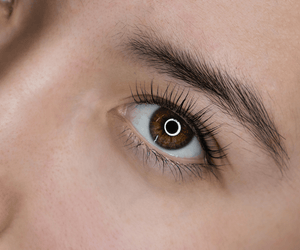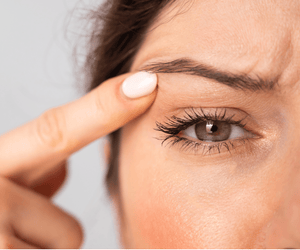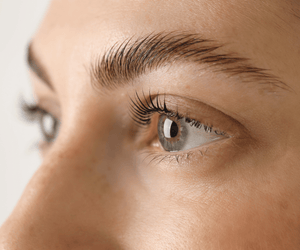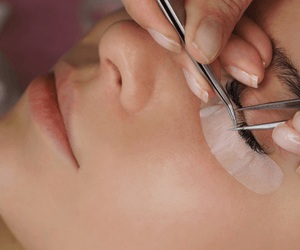
The way makeup has evolved throughout the years is fascinating. Men and women alike have gone to painstaking lengths to beautify themselves, especially to enhance their eyes.
You’re probably already familiar with the story of ancient Egyptians darkening their lids and lashes with kohl. Maybe you even know about the invention of mascara by Eugene Rimmel in the 1830s. But today, we will focus on an innovation that is unlike any other makeup product! Welcome to our deep dive into the history of fake eyelashes.
Table of Contents
The Early History of False Eyelashes
The early history of fake eyelashes started in the 19th century, with a few articles published mostly by male writers. The articles described how women artificially enhanced their lashes by sewing their own head hair into the eyelid or by having a hairdresser do it for them.
While these stories popped up several times in European newspapers, the notion that this was common is hard to believe.
Another myth alleges that the first fake lashes were created by a French sex worker. The salacious tale (which has been thoroughly debunked) suggested that the lashes helped protect women's eyes during illicit activities.
On the other hand, there are far more convincing theories that hairdressers and wig makers custom-created false lashes for clients, especially actresses who need to enhance their eyes on stage. Often made of trimmed human hair, these early fake lashes were likely attached to the eyes using surgical glue.
1910s: The First Patents
The first patent for a fake eyelash product was recorded in 1902 in the UK, along with a patent for false eyebrows. These first false lashes were created by German hairdresser and inventor Charles Nessler (who also went by Charles Nestler).
Marketed as Nesto Lashes, they looked a lot like today’s modern invention, although they were made of very different materials.
According to makeup history researcher James Bennett, the band (which was referred to as the “foundation”) was made of fish bladder. Small clippings of human hair were threaded through it to mimic the look of lashes.
As reported in the papers at the time, the lashes were attached with a “skin fluid” adhesive, which was likely similar to spirit gum. This adhesive allowed those early lashes to stay put for up to 10 days, much like today’s DIY lash extensions.
Nessler’s lashes, sold as Nesto Lashes, were available in two designs: Soft, natural-looking lashes developed for “society” wear and larger, more dramatic fake lashes developed for the stage.
Eventually, Nessler moved to the United States, where he continued to market his false lashes. He eventually filed a US patent in the 20s. He was a talented inventor and also went on to create the early iterations of the hair curler.
Some competition for Nessler cropped up in 1911 when Canadian inventor Anna Taylor filed the first US patent for false lashes. Taylor’s lashes were made of hair attached to an unspecified strip of clear material. The patent describes the lashes in detail, along with an accompanying chart.
There is also a famous story about the filming of the movie Intolerance in 1916. Director D.W. Griffith asked his wig maker to create false lashes. He wanted them to help the film’s lead, actress Seela Owen, appear more otherworldly.
The unnamed wigmaker complied, creating large lashes that were attached to the actress’ eyes using spirit gum. According to actress Lilian Gish, Seela Owen actually came on set one day with her eyes irritated and swollen as a result of the strong adhesive.
In the coming decades, many other beauty entrepreneurs and makeup artists would soon develop their own versions of fake lashes, and change the makeup world forever.
1920s: Catering to Hollywood
In the 1920s, the history of fake lashes was closely intertwined with the history of cinema.
In daily life, many women do not wear makeup at all. Those who did only used mascara to enhance their lashes. In the movies, it was a different story.
Actors had to apply dark, stark makeup so their features would pop in the early black-and-white films. Silent film stars like Clara Bow and Louise Brooks appeared in dark-rimmed, heavily lidded eyes enhanced by false lashes and thick coats of mascara.
Many of Hollywood’s makeup artists and wig makers helped pioneer these looks, with Max Factor’s name standing out.

1930s: The Arrival of Boxed Lashes and Lash Grafting
Boxed lashes became more widely available throughout the 1920s and 1930s, largely from Max Factor and Nessler’s respective brands. Thanks to these entrepreneurs, it became a little more common for women to wear false lashes in the 1930s, especially before special occasions.
In 1933, Marjorie A. Birk patented fake lashes created with a new method. Instead of gluing hairs to a strip of gauze or a fish bladder, she knotted the lashes through a thin strip of cotton for a far more flexible design. Birk’s company, Ey-Teb, was still in business well into the 1960s.
Beauty salons and makeup studios also started offering professional “lash grafting” services. Lash grafting was a careful process that’s extremely similar to today’s professional lash extension applications.
Benett cites an article from the 1936 magazine Beauty Culture, where D.A. Eaton provides a detailed explanation of the process and even compares strip lashes to “lash grafting.”
1940s - 1960s: The Big Lash Shift
During World War II, the beauty industry saw a temporary decline as most manufacturers switched their focus to support the war efforts. Society championed a more practical, demure look, which didn’t include false lashes.
Once the war ended and Hollywood’s Golden Age entered full swing, false lashes had their comeback as well. It was a while before there were any notable recorded changes in the industry, though.
The next big shift change came in the 1960s. Elizabeth Taylor’s look in Cleopatra transformed previously held makeup standards, ushering in a new look with dark eye makeup, pale lips, and large, noticeable false lashes.
Supermodel Twiggy’s lashes were also instrumental in making false lashes more normalized in day-to-day life as part of the mod makeup look.
In an ad for false lashes by Yardley, Twiggy looks straight-on at the camera, with drawn-on lower lashes and dense, fluffy falsies enhancing her upper lashes.
Taking inspiration from Twiggy, some women also experimented with applying false lashes to their lower lash lines to create a very intense, open-eyed look.
Many more brands started selling false lashes during that decade, including Revlon, Elizabeth Arden, and Eylure (which also pioneered the first mink fur lashes). These brands created lashes in different styles, and in the 1970s, we also had records of instructional booklets explaining how to apply them.
Innovations in Later Half of the 20th Century
By the 1970s, most brands outsourced their production to countries with more affordable labor, such as South Korea and India.
Some brands took inspiration from women who cut their strip lashes and started creating clusters and flare lashes. These became popular with makeup artists who wanted a more natural-looking alternative to strip lashes to match the more subtle approach to makeup in the 1970s.
While changes to the industry would have made false lashes more accessible, they still weren’t popular in daily life. Even in the ‘80s, when makeup was bold and colorful, mascara still reigned supreme!
Modern Lash Advances
The 2000s and 2010s brought a whole new series of lash innovations. Over the last few decades, we have seen unique and exciting changes to false eyelash materials, resulting in cruelty-free, vegan lashes that look very soft and natural. There are more style options than ever, with everything from extremely natural designs to dramatic ones to unique and creative ones.
Some innovations have come and gone, like two-part magnetic lashes. These were soon replaced by single magnetic lashes that adhere to the lash line with magnetic eyeliner.
Professional eyelash extensions also had a resurgence, with enhanced regulations and safety standards keeping customers safe.
The Future of Lashes: DIY Lash Extensions
The history of fake eyelashes is both glamorous and odd, from those early reports of women sewing hair directly into their eyelids (doubtful) to the litany of Hollywood starlets who used bold lashes to better express themselves on the screen.
We’re excited to take part in the future of false lashes with DIY eyelash extensions that fit against the underside of the lash line and stay put for days at a time. They combine the best elements of lash extensions and false lashes with an easy-to-apply application process and a natural-looking effect.








